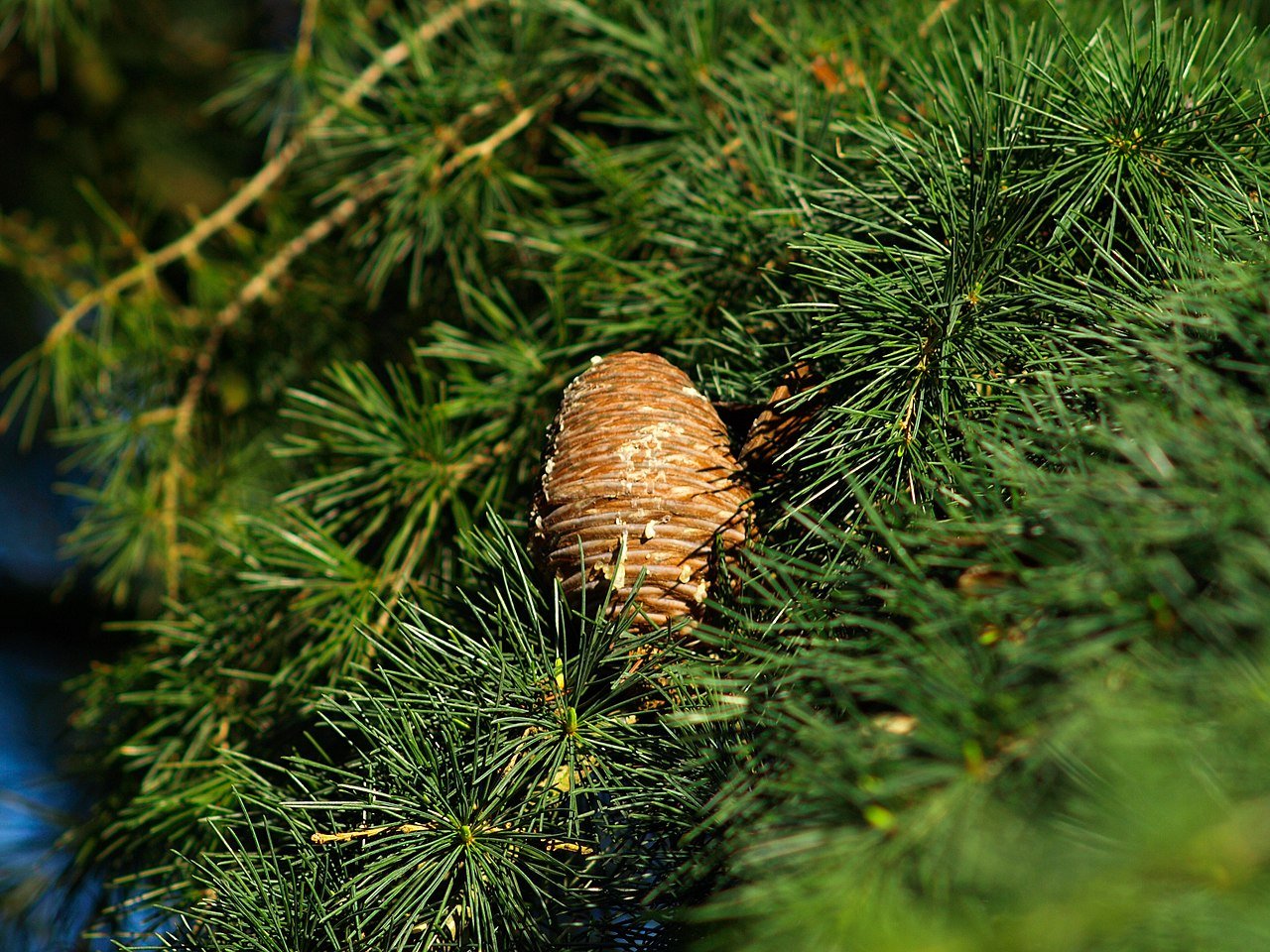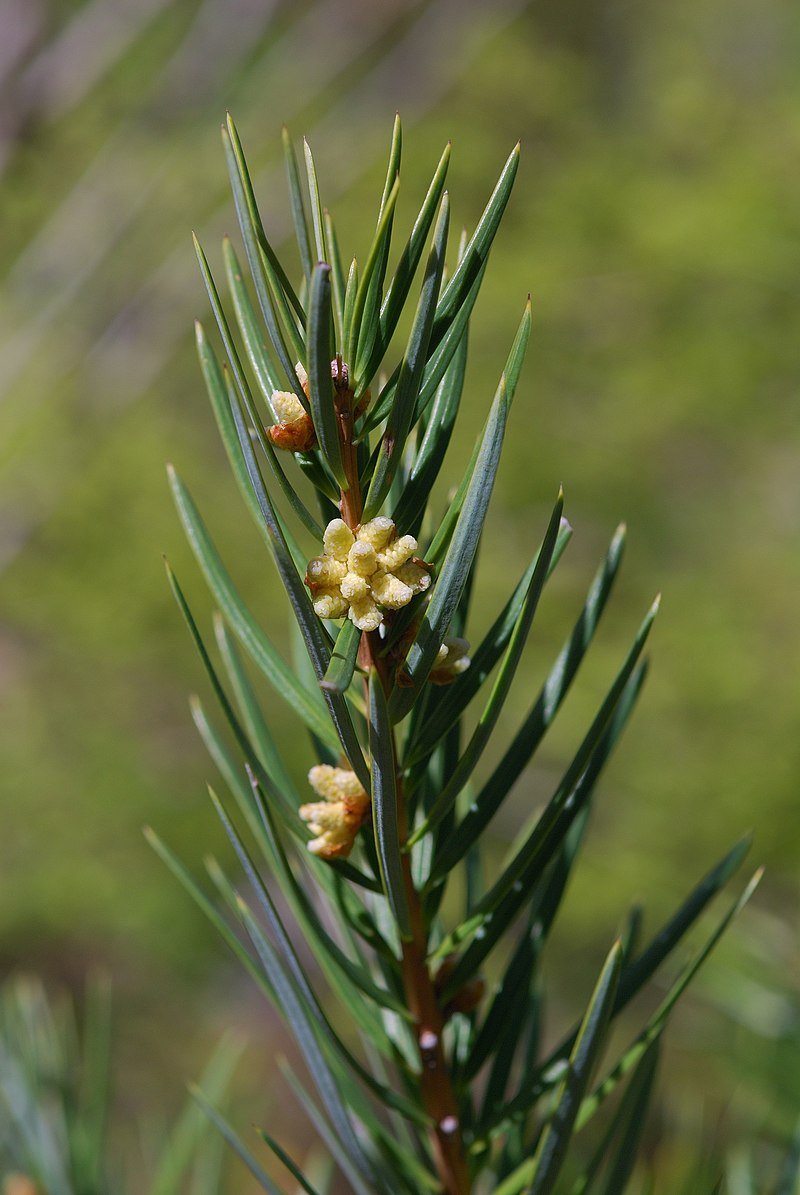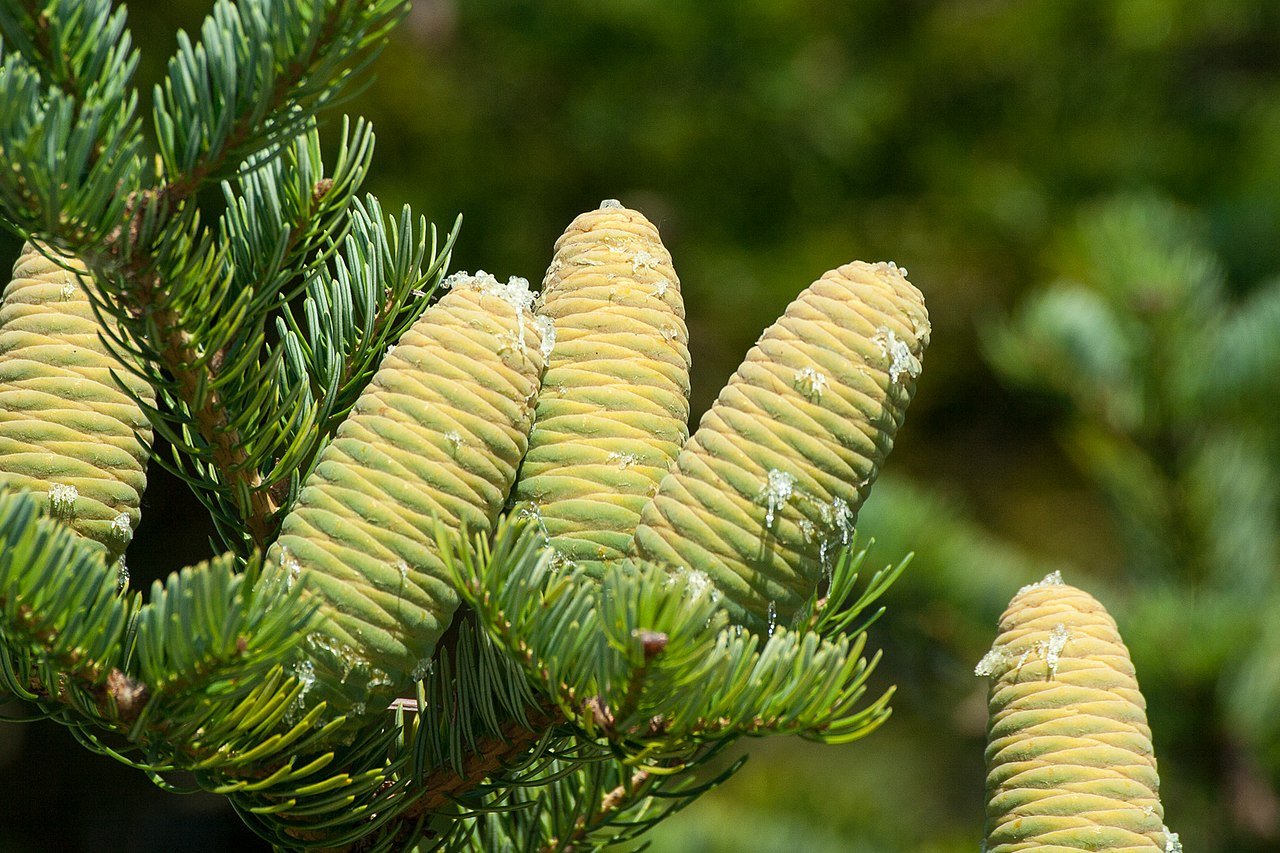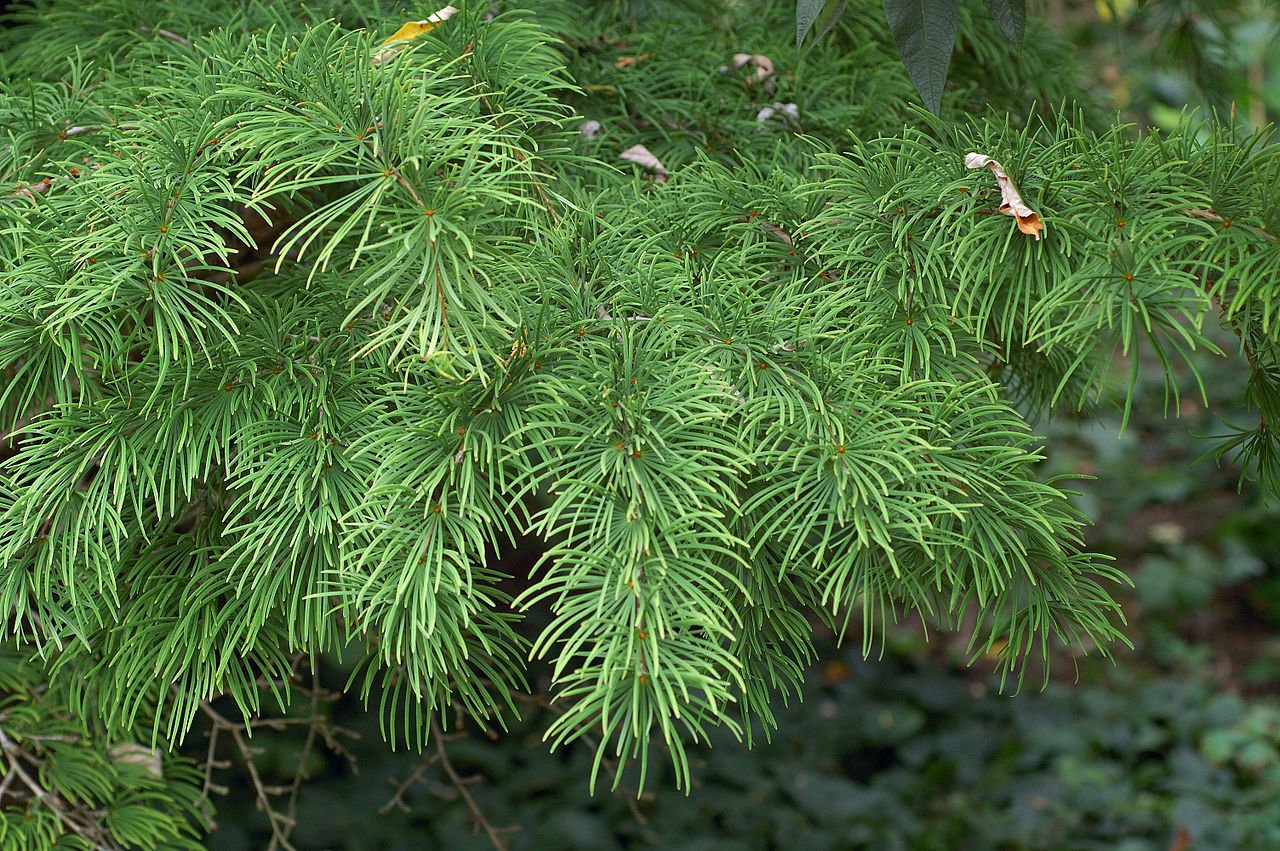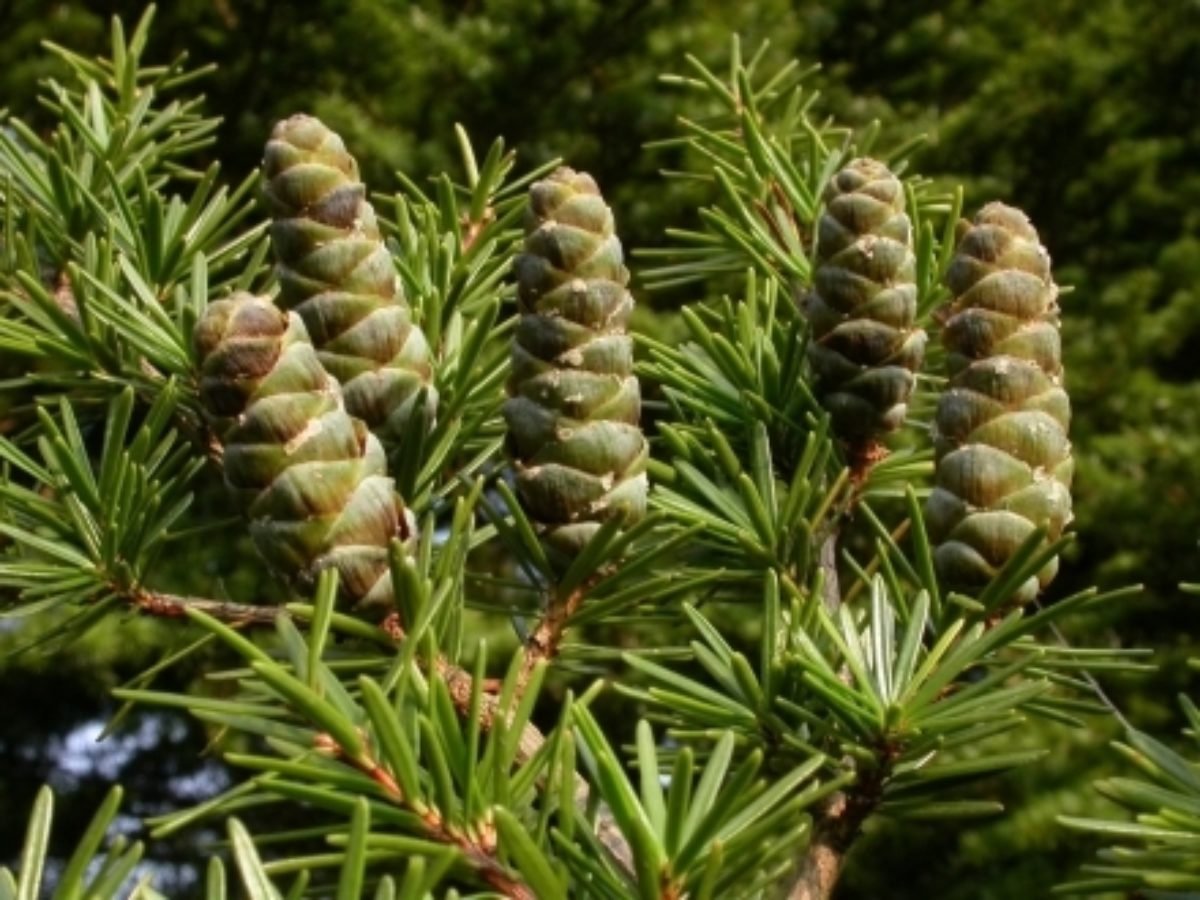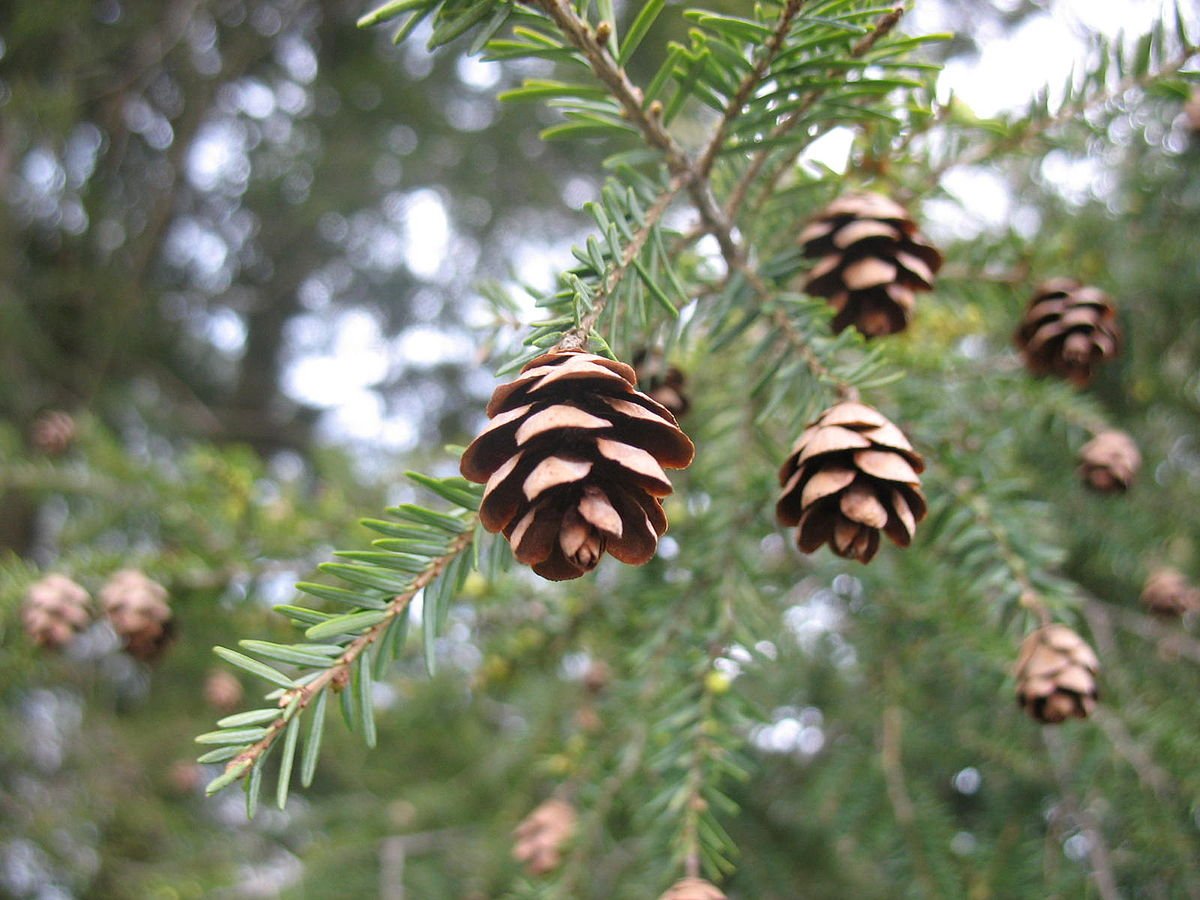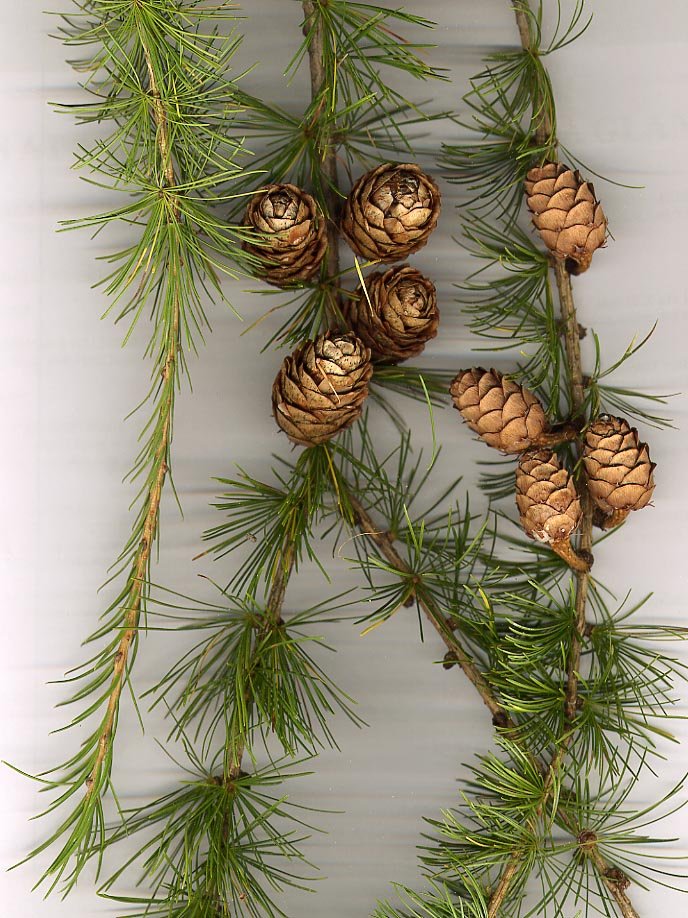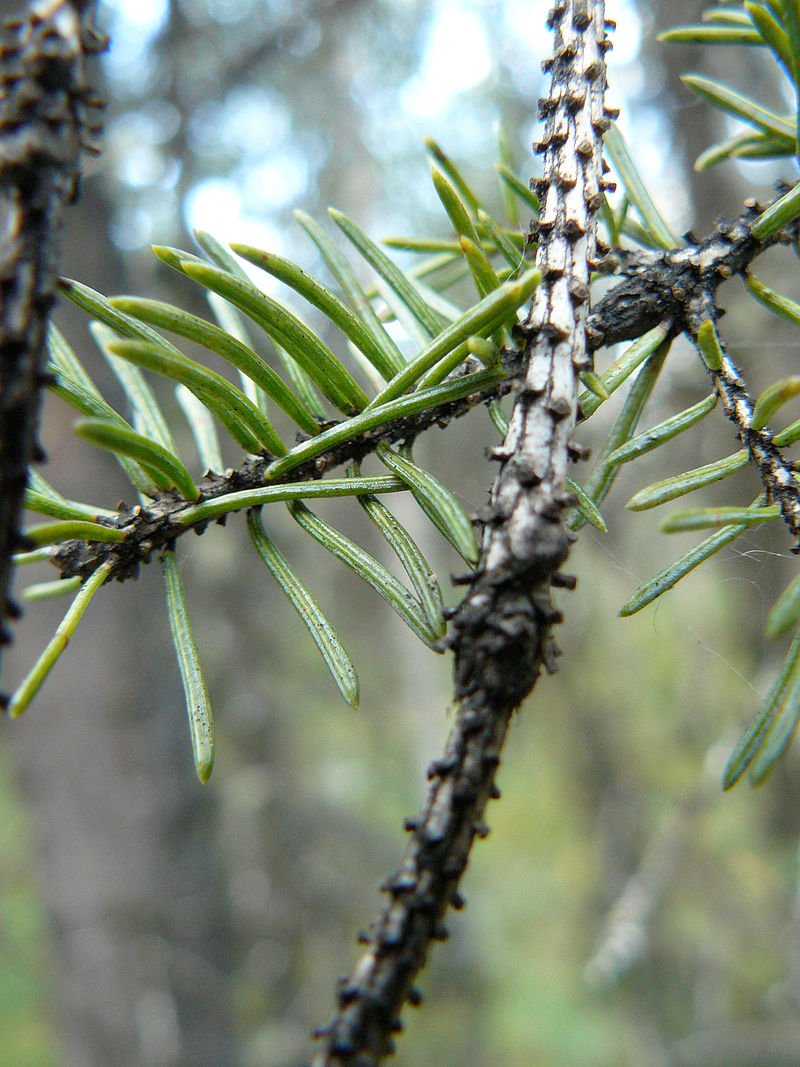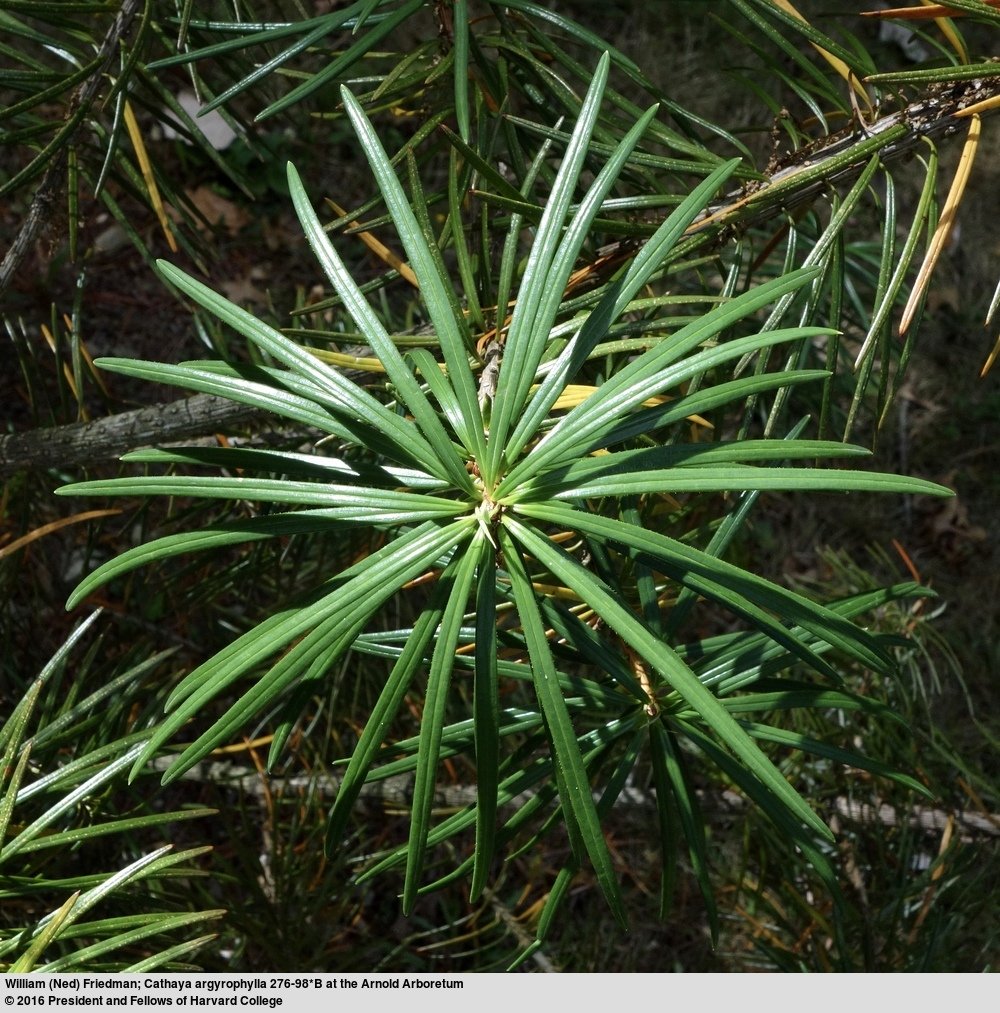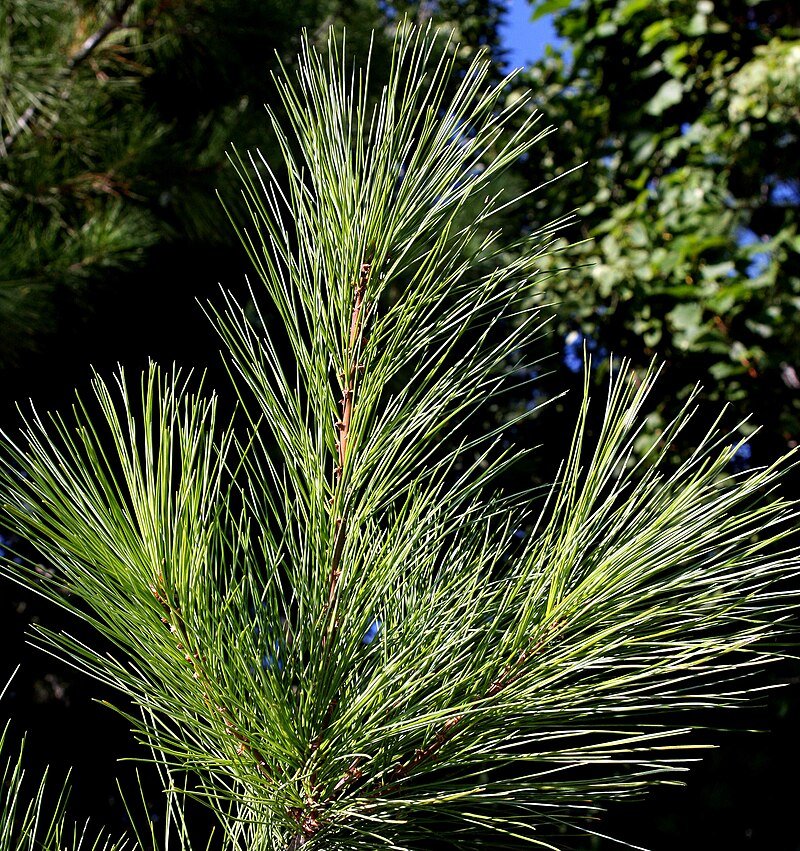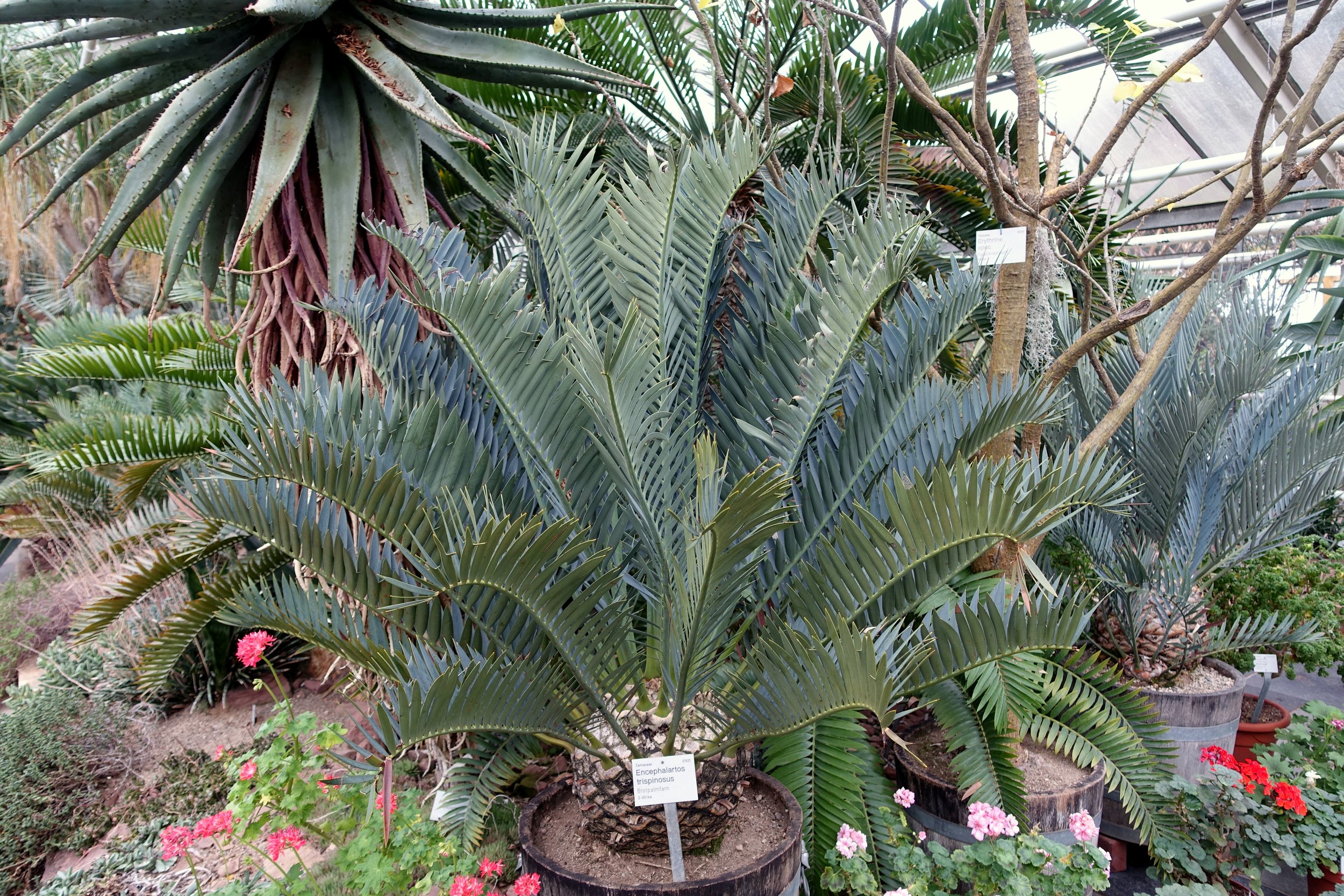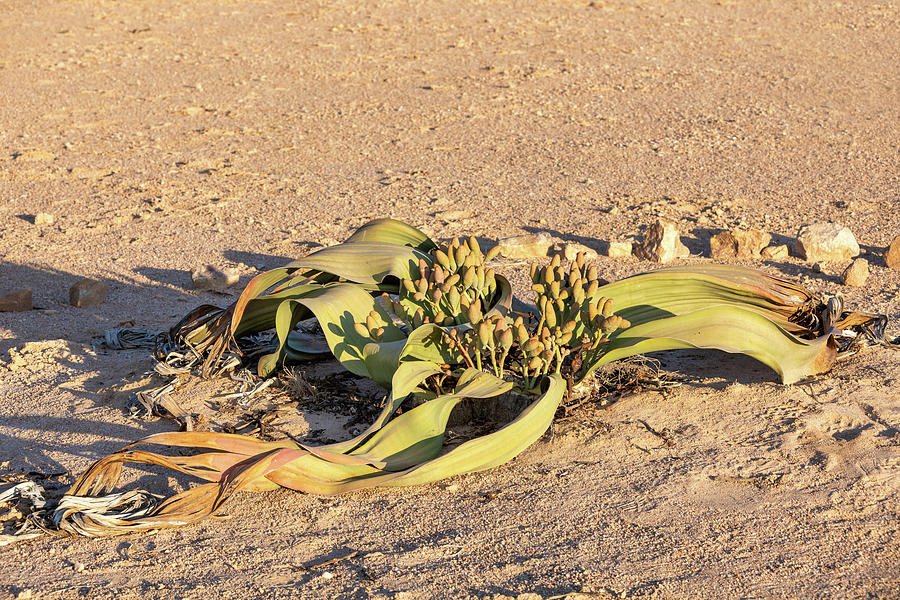You remember from high school biology kingdom, phylum, class, order, blah blah blah, right? Those are the basic categories all organisms are classified with: it’s called taxonomy (or systematics), and those terms are used in another science called phylogeny. To be totally honest, the ways these sciences differ aren’t very clear to me.
Whatever we call it, I find these topics fascinating. If you don’t yet think these sciences are compelling, maybe another pinch of evolutionary tree bio will pique your interest.
When you imagine an evolutionary tree or family tree, what you’re seeing is actually called a phylogenetic tree.
An awesome scotch pine (Pinus sylvestris) Sam and I found at Morton Arboretum in Chicago, IL
And I want to talk about some phylogenetic trees of some trees. Last time I wrote about evolutionary biology I wrote about how trees on earth are the “final form” of plant lineages, using the fact that many plant lineages converge on tree-like form as my primary supporting argument. This article ties together a bit with that one, but we’ll be focusing on the whole group of gymnosperms here. You know, trees like pines and their friends.
It’s kind of like going to your in-laws for the holidays. Even after you know everyone’s names, the bigger picture doesn’t make sense until you know how the family tree looks. Who is mother to who, who is an aunt to who, who are cousins, etc.. The chart we’ll go over in this article helps make sense of the gymnosperms in that way. It gave me a deeper appreciation for them, so I thought I’d share.
First let’s talk about some general terms, and then I’ll dive more specifically into some gymnosperm phylogenetics. I know the primer on terms is long but I promise you it is worth it. If you’re already comfortable with basic taxonomic terms, feel free to skip to the Gymnosperm section.
Terms
These are terms from the Linnaean system, the earliest formal method for classifying organisms. Even today, lots of these terms are used. Don’t let the Latin names freak you out, it’s all good. Just more words.
We’ll focus mostly on orders, families, and genera in this article.
The other categories are important too, but for the sake of this article, I’m only going to be focusing on these lower classifications. There are generalizations that can be applied to higher levels just like the ones at the lower levels we’re about to explore.
I’ll be making some comparisons to mammals, since we have some innate intuition about them. But those examples are just for the sake of flushing out our understanding. These parallels help me understand just how unrelated some plants are to each other, and they’ll probably help you too. The examples used are approximations, not super precise.
Order:
This is sort of as high up as our own natural intuitive classifying of animals/plants go. Without thinking too hard, we all sort of understand that rodents and dogs are distantly related, right? Both are mammals, but rodents belong to an order called the Rodentia and larger carnivores belong to the order Carnivora. And you wouldn’t intuitively lump them together.
They both share some common physical traits (their ‘morphology’), and some common genes.
In the gymnosperms we’ll be talking about, examples of orders are the Pinales, where pine are classified. Another order is the Cupressales, where the cypress are. In essence, you could think of the pine and cypress to be as similar or different as rodents are to the bigger carnivores like dogs. Kind of.
Cool, right?
Family:
Carnivores are broken up into a few families too, two popular ones are the Canidae (dogs) and the Felidae (cats). There are many different types of canids (animals in the Canidae family), but all of them are contained within a single family, unified by a narrower set of common physical traits (morphology) and a narrower set of common genes. Again, families are something we can sort of intuit. Family names across all taxonomy tend to end with -deae or -dae or -ceae.
Still following me?
A gymnosperm family within the Pinales order is the Pinaceae, or pine family (which is further divided into sub-families, which we’ll talk about). A family in the Cupressales order is the Cupressaceae, which is the massively diverse cypress family.
If you’re familiar with the Latin names of plants, you’ll start to see some familiar words at the family level.
Genus:
And mice and dogs and cats can be broken down further, right? Muridae (the rodent family containing mice, rats, and gerbils) contains genera (plural of genus) like the variety of different mice and different rats. True mice belong to the Mus genus, and true rats belong to the Rattus genus. Again, these are narrower sets of common morphology and genes.
Some examples of dogs in the Canidae are the foxes (Vulpes) and wolves (Canis), and examples of cats in the Felidae are panthers (Panthera) and lynx (Lynx). Both canids and felids contain our domesticated pets too, common dogs and cats.
Some genera in the pine family are the true fir (Abies), and the hemlock (Tsuga), and of course the pine (Pinus). And the cypress family contains some genera like the dawn redwood (Metasequoia) or true sequoia (Sequoia).
Red fox (Vulpes vulpes) (photo source) | Eurasian wolf (Canis lupus lupus) (photo source)
Balsam fir (Abies balsamea) | Eastern hemlock (Tsuga canadensis) (photo source)
The differences between foxes and wolves might be a good analogy for the differences between fir and hemlock, for example. Kind of. In the same families, but really start to differentiate from each other in obvious (yet similar) ways at the genus level.
Species:
Subspecies exist, but generally the species level is as specific as we get. Any individual organism’s scientific name is usually written as Genus + species. It is a standardization to capitalize the Genus and italicize both genus and species. Not sure why, but those are the rules.
Are there more than one kind of fox or wolf? Of course. Same with panthers and lynx and rats and mice.
Some species in the Abies genus are the grand fir (Abies grandis) or the white fir (Abies concolor). Species in the Sequoia are the Sequoia sempervirens and the now extinct Sequoia affinis.
Final notes on systemics/taxonomy/phylogeny:
Each order, family, genus, or species have requirements for an organism to fall into. And when organisms are discovered that do not meet any existing ones, sometimes subcategories are created. If you look into these topics beyond this article, you might find suborders, subfamilies, etc.. But for this article, we’re keeping it mostly simple.
Alaska Cedar (Callitropsis nootkatensis) we take care of in Birmingham, MI
Like any science, there is debate among its practitioners. Phylogeny and taxonomy are constantly changing little minute details, and so what you see here may be somewhat different in even five years. Keep that in mind when looking more into phylogeny.
One example that I experienced was the reclassification of the alaska cedar. In school I learned this species as Chamaecyparis nootkatensis. But in 2021 a genetic analysis was done on this species and determined it did not belong in the Chamaecyparis genus, and it was relocated to the Callitropsis genus. Now the plant is technically Callitropsis nootkatensis.
Sometimes plants and animals can easily be categorized, and others require microscopes or genetic analysis to determine where they might fit.
Gymnosperms
We can’t talk about gymnosperms without talking also about angiosperms. Angiosperms and gymnosperms are two gigantic groups of plants that reproduce sexually with seeds. This separates them from plants that reproduce with spores, like ferns and mosses.
Developing seed-cones of norway spruce (Picea abies), a gymnosperm (left) | Fruit of the nearly extinct american chestnut (Castanea dentata), an angiosperm (right)
Angiosperms contain a bazillion different plant species from oak trees to sunflowers. Within the angiosperms are the “dicots” and “monocots” you might be familiar with too. They surround their seeds with fruit which serves many varying functions depending on the plant (protection, nourishment for the seedling, aiding in distribution, etc..).
Gymnosperms, by contrast, have unfertilized seeds that are not protected by any fruit. The cone of a pine tree is not a fruit, but an entirely different organ (called a strobili) that props up the seeds to make fertilization easier. The difference between fruit and no-fruit may seem small, but it is a primary factor in what separates these two groups.
All gymnosperms are woody plants, and there are about 1000 to 1200 species of them (depending on how you slice things up).
I made this table to compare just how much more diverse the angiosperms are compared to the gymnosperms:
Quite the difference. And while there is 250-times more angiosperm diversity, gymnosperms represent approximately 7% of all land plants, and are the dominant trees in 39% of forests. They share their growing environments with angiosperms in some biomes, and are the dominant trees in other biomes. Gymnosperms are highly successful plants.
The angiosperm phylogeny chart is massive and complex, and the gymnosperm phylogeny chart is smaller to digest and a bit less daunting of a writing assignment. The amount of work done on angiosperm phylogeny is truly jaw-dropping.
In a study published in 2022 in the Chinese academic journal Plant Diversity (an awesome journal, highly recommend), a group of scientists resolved the relationships between the major groups of gymnosperms by analyzing the last ten years of phylogenetic research. The article is aptly titled Recent Advances on Phylogenomics of Gymnosperms and a New Classification. From hereon I may refer to this study as ‘this study’.
This study represents the most current and most thorough classification there is of this group of plants, it is a group that us arborists interact with frequently. The main focus of this article is on an awesome chart the authors created in their study.
Recent Advances on Phylogenomics of Gymnosperms and a New Classification:
OK, this chart is complicated, but please take your time checking it out because once you see how it flows, it is brilliant. I’ll explain how to read it after you check it out first. I guess I should say here, before we go further, that knowing the Latin names of your local trees makes appreciating this chart much easier. Most of the chart is original to the Chinese study I mentioned earlier; the only things I added were the labels for the class, sub-class, order, family, sub-family (the study refers to them as ‘tribes’), and genus.
from Recent Advances on Phylogenomics of Gymnosperms and a New Classification (modified by Tree First with labels)
Something I found useful was the color-coordination and the vertical lines on the right with the phylogenetic tree on the left. Let me zoom into something to help make sense of the chart:
A zoomed in section of Recent Advances on Phylogenomics of Gymnosperms and a New Classification (modified by Tree First with labels)
Everything left of the Pinidae sub-class falls into that sub-class (I added pink shading to illustrate this). The color of the sub-classes corresponds to the color of the tree on the left side of the image too. The pink of the Pinadae extends to the pink branches of the tree.
Continuing with the flow of the chart, the Pinales order is within that sub-class. The Pinaceae family is within the Pinales order, and that is broken up into two sub-families: the Abietoideae and the Pinoideae. The genera that align with the blue sub-familiy Abietoideae (I added blue shading to illustrate this) are classified in that sub-family: The Cedrus, Keteleeria, Abies, Pseudolarix, Nothotsuga, and Tsuga. You’ve undoubtedly worked with some of these trees in the field.
This design is true for all of the classifications I labeled. OK now zoom back out. The alignment methods this chart uses is brilliant.
Since we already took a glance at the Pinidae, let’s check again at the genera in that sub-class. Since it is the highest classification that contains “pin” in it, we’ll call it the pine sub-class.
Pine Sub-class | Pinidae
The pine sub-class contains only a single order, the pine order, and one family, the pine family. [Abie]-toideae, we could call it the fir sub-family. The [Pin]-oideae, the pine sub-family.
A zoomed in section of Recent Advances on Phylogenomics of Gymnosperms and a New Classification (modified by Tree First with labels)
Pictured below are some examples the genera in the fir sub-family (Abietoideae) again: The Cedrus (true cedar)(image source), Keteleeria (keteleeria)(image source), Abies (fir)(image source), Pseudolarix (golden larch (not true larch))(image source), Nothotsuga (bristlecone hemlock)(image source), and Tsuga (hemlock)(image source).
The genera in the pine sub-family are: Pseudotsuga (douglas fir)(image source), Larix (true larch)(image source), Picea (spruce)(image source), Cathaya (Cathaya)(image source), and Pinus (pine)(image source). Examples below.
True cedars in the fir sub-family were not all that surprising, and seeing it close to fir makes sense to me for some reason. Morphologically these genera have a lot in common, erect cones, simple needles, etc..
Hemlock (Tsuga) and bristlecone hemlock (Nothotsuga) were interesting to me too (I had never previously heard of bristlecone hemlock). There are about 10 species in the Tsuga genus, but only a single one in the Nothotsuga. This one species can’t be lumped in with the hemlocks?
Eastern hemlock (Tsuga canadensis) left (image source) | Bristlecone hemlock (Nothotsuga longibracteata) right (image source)
Nope. Bristlecone hemlock are apparently significantly different genetically and morphologically from hemlock. The single species within the Nothotsuga genus may indicate that it is a less successful lineage of plants. This might suggest past species in the Nothotsuga either didn’t speciate or the directions they speciated in were not viable and reached dead-ends (went extinct).
Douglas fir (Pseudotsuga menziesii) left | Eastern larch (Larix laricina) right
Another surprise to me was the placement of douglas fir (Pseudotsuga) into the pine sub-family instead of the fir sub-family. I very easily assumed this would be near the hemlock or fir, given its genus translates to “false hemlock”. But no, apparently they are most closely related to larch? How cool.
My intuition also did not place spruce (Picea) in the pine sub-family. I figured it would be in the fir sub-family. I guess in my head the spruce were the “sharp firs”. Nope.
Cypress Order | Cupressales:
The cypress sub-class takes up a lot of real estate on that chart, so we’ll check it out by order instead: first, the Cupressales. If you look closely, the order contains four families, not two. The Sciadopityaceae and Cephalotaxaceae families are nestled in the sub-family column, but as indicated by their color, they are families. Those families don’t have sub-families, and probably don’t contain many species within their respective genera.
But the two major families are the Cupressaceae and the Taxaceae. The cypress-family and the taxus-family, respectively.
Cypress-family is huge with seven sub-families, some more diverse than others:
Cunninghamoideae | Cunninghamia sub-family
Taiwanioideae | Taiwania sub-family
Athrotaxidoideae | Athrotaxis sub-family
Sequoioideae | Sequoia sub-family
Taxodioideae | Swamp cypress sub-family
Actinostroboideae (aka Callitroideae) | Actinostrobe sub-family
Cupressoideae | Cypress sub-family
In gymnosperm phylogenetic trees from the recent past, the sequoias were all placed within the bald cypress subfamily, but current ones have separated them into their own family. The sequoia sub-family (the Sequoioideae) holds little surprises, containing the genera for giant redwoods, coastal redwoods, and dawn redwoods. The swamp cypress sub-family, the Taxodioidae, contains the iconic american swamp cypress, chinese swamp cypress, and surprisingly cryptomeria. Surprising in that it isn’t morphologically all that similar to either of the swamp cypresses. Check out the comparison below.
Cryptomeria japonica on the left, and Taxodium distichum on the right. Very different foliages and growth habits.
Not an intuitive relation to me, but cool nevertheless. Both textures and most of the other visible morphology are very different among these two.
The actinostrobe sub-family was interesting to look into since I haven’t worked with any of these genera in practice. I think all of the plants in the sub-family are indigenous to the southern hemisphere. I don’t have much to say about these trees other than it would be cool to see them in person, especially the fitzroya.
The cypress sub-family (Cupressoidae) is where we find things we generally could refer to as cypress. Lots of false cedars in here too like Thuja, Chamaecyparis, and Juniperus. This study also removed a lot of plants from the Juniperus genus and placed them into their own, new genus Sabina. They cite many morphological differences and genetic analyses as reasons to establish them in their own unique genus, instead of being lumped into the Juniperus.
When you look them up like I did, most information you’ll find refers to them as sabina junipers, which I had never heard of (show pics probably). Similarly, a single species of juniper was also given its own genus, the Arceuthos. It was previously Juniperus drupacea.
Ginkgos & Cycads:
Ginkgo biloba leaves (image source)
Ginkgos have received a lot of attention over the years. It has so many odd characteristics that don’t neatly align into any of the established classes, and so has been difficult to classify. The Chinese study touches on ginkgo’s previous classifications. It used to be grouped in with other conifers close to the Gnetidae, only ever receiving its own sub-class.
Now, though, they confidently have given the ginkgo its own class. After citing three other studies: recent studies based on thousands of single-copy nuclear genes, the authors also conclude the sub-class of ginkgos is a close relative to the cycads.
A zoomed in section of Recent Advances on Phylogenomics of Gymnosperms and a New Classification (modified by Tree First with labels)
Encephalartos trispinosus, a species of cycad (image source). I tried to grow one of these in my collection and it sat idle for about four years. A plant I found challenging to grow.
Moving the ginkgos to the complete other end of the phylogenetic tree is quite the move, especially when you consider how different cycads and ginkgos appear to be. It shows that relying on morphology alone isn’t the best metric for understanding how organisms relate, and how combining both phylogeny with morphology can lead to changes like these.
The class of cycads is an interesting one, I think we often forget they are gymnosperms. While the wood they form isn’t quite like what we think of when we think of other plants here, there are some that definitely have tree-like form.
The cycads having their own class isn’t surprising, but I think cycads being in the conversation at all might be. A lot of people intuit that cycads are closely related to palms, given they look very similar and grow in similar environments. But it is another great example of why morphology alone isn’t the best method for classification.
An awesome phylogenetic tree showing when major groups of plants evolved (modified by Tree First with labels) (image source)
The above chart is awesome, I’ve used it before in other articles. Cycads evolved approximately 150 million years before palms did, on an entirely different evolutionary lineage of plants. Their similarities are due to converging on similar strategies, which a lot of plants do. Convergence isn’t always an indicator that things are related, but instead suggests evolution favors strategies that work.
Gnetidae:
This sub-class falling into the pine class (Pinopsida) is kind of odd. The only plant I was vaguely familiar with in this sub-class were the Welwitschia, a plant I’d seen in a nearby botanical garden. What’s really fascinating about Welwitschia is that they only ever grow two leaves. That’s it.
Truly an odd plant. They live hundreds of years looking this way. Welwitschia mirabilis (photo source)
To be totally frank with you, the plants look like a ragged mop head. But say whatever you want about the Welwitschia, their two leaves can support this plant’s thousand-year lifespan. Insane!
Here’s what the research paper said about the Gnetidae:
Gnetophytes [plants in the Gnetidae family] have a number of unusual characters, e.g., bisexual cones, vessels in secondary wood, ovules partially enclosed in one or two outer envelopes, dicot-like pinnately veined broad leaves in Gnetum L., modified to a membranous sheath in Ephedra L. and giant strap-shaped leaves in Welwitschia, archegonia absent in Gnetum and Welwitschia but present in Ephedra. This unique set of characters has led many people to believe that the gnetophytes are direct ancestors or relatives of ancestors of the angiosperms.
Being the progenitors of angiosperms is a fascinating hypothesis based on morphology. Even though it is well-founded, the genomes Gnetaceae and Welwitschiaceae indicate they belong to the Pine class (Pinopsida). Which, to be fair, I still can’t quite wrap my head around.
As you can see clearly in the photo above, if you were to simply tell me the Welwitschia were in the pine order I would definitely think you were joking.
Questions to end on
Both before and even after looking into gymnosperm phylogeny I had some questions about the families and subfamilies. I was deeply curious about what specific morphology the plants in any sub-family have in common. Yes, I understand in a zoomed-out sense that these are based on a combination of morphological and genetic analyses. But in a more zoomed-in and hands-on example, what does it specifically take for a tree to be in the pine sub-family or the fir sub-family?
Sometimes this information was easy to locate, but other times I spent 30 minutes on a single search without finding anything that satisfied me. I’d spend time reading an article only for it to land on the conclusion that plant systematics are complicated (and yeah, I get that), or finishing an article to see it was published in the year 1990.
And sometimes certain classifications aren’t very flushed out just yet because nobody has taken the time (or has had the interest) to explore them at levels the authors of this study went to.
The qualifications to be in any family, genus, or species can be broad or they can be very specific, and changes occur when a study looks closely at them. One broad separation between two sub-families could be the distribution of resin canals within the wood, or the arrangement of stomata on the leaf. Other differences are nearly microscopic, and they are so unique to each species that I couldn’t possibly dive into even a few without tripling the length of this article.
I was hoping for easy answers, but I didn’t really get them.
Ending of lineages (and this article lol)
Things don’t evolve in one ‘ideal’ direction. Things evolve in every direction, but only the directions that work persist and carry on. Plenty of lineages begin and die. The disparity between the diversity of species among the gymnosperms and angiosperms is partly due to them evolving millions years first. Gymnosperms are often considered to be more “primitive” or “ancient” plants than angiosperms.
Generally speaking, angiosperms are “quicker to adapt” to changing environments than gymnosperms are. Not to bum you out too much, but I should share while digging into this topic, a lot of the gymnosperms I looked into were on IUCN the endangered species list. Like all plants, gymnosperms are losing massive swathes of habitat for our own anthropocentric recklessness, and their numbers dwindle on account of their ancient physiology.
It would be a shitty feeling to see a number of these lineages end at our hands. Hundreds of millions of years of successful evolution to come to an end because of us. It happens a lot, and it the absence of gymnosperms will certainly be noticeable.
This chart introduced me to a ton of gymnosperm genera I’d never heard of. Parasitaxus? Halocarpus? Pectinopitys? It also got me looking into cycad species which are also insanely cool, some have tree-like forms! I mentioned those in the convergence article too. And it deepened my understanding of how the gymnosperm family tree looks. Who is cousin to who.
I hope looking at a chart like the one we’ve gone over is interesting to you too, and if you’ve scratched your chin at least once reading this article, I’ll have done what I set out to. Just don’t go creating a phylogenetic tree for your in-laws. Or at least don’t show it to anyone.
If ya made it this far, thank you.









